A Four-Port Dual-Band Dual-Polarized Antenna for Ku-Band Satellite Communications
Abstract
1. Introduction
2. Antenna Design and Working Mechanism
2.1. Antenna Configuration
2.2. Working Mechanism
3. Experimental Results and Discussion
4. Conclusions
Author Contributions
Funding
Institutional Review Board Statement
Informed Consent Statement
Data Availability Statement
Conflicts of Interest
References
- Gultepe, G.; Kanar, T.; Zihir, S.; Rebeiz, G.M. A 1024-element Ku-band SATCOM dual-polarized receiver with >10-dB/K G/T and embedded transmit rejection filter. IEEE Trans. Microw. Theory Tech. 2021, 69, 2484–3494. [Google Scholar] [CrossRef]
- Joo, T.; Hwang, C.; Park, J.; Kim, K.; Jung, J. Design of a tile-type Rx multi-beam digital active phased array antenna system. J. Electromagn. Eng. Sci. 2022, 22, 12–20. [Google Scholar] [CrossRef]
- Sandhu, A.I.; Arnieri, E.; Amendola, G.; Boccia, L.; Meniconi, E.; Ziegler, V. Radiating elements for shared aperture Tx/Rx phased arrays at K/Ka band. IEEE Trans. Antennas Propag. 2016, 64, 2270–2282. [Google Scholar] [CrossRef]
- Kang, Y.-G.; Kim, C.-K.; Park, S.-O. Ocean image formation algorithm using altimeter data for next generation satellite SAR. J. Electromagn. Eng. Sci. 2022, 22, 85–94. [Google Scholar] [CrossRef]
- Kim, S.; Nam, S. Design of a relocatable antenna element module for a Ku-band reconfigurable array with low mutual coupling. J. Electromagn. Eng. Sci. 2022, 22, 534–536. [Google Scholar] [CrossRef]
- Weily, A.R.; Nikolic, N. Dual-polarized planar feed for low-profile hemispherical Luneburg lens antennas. IEEE Trans. Antennas Propag. 2012, 60, 402–407. [Google Scholar] [CrossRef]
- Zaghloul, A.I.; Gunta, R.K.; Kohls, E.C.; Sun, L.Q.; Allnutt, R.M. Low cost flat antennas for commercial and military SATCOM terminals. In Proceedings of the MILCOM Communications for Network-Centric Operations: Creating the Information Force, McLean, VA, USA, 28–31 October 2001; Volume 2, pp. 795–799. [Google Scholar]
- Vaccaro, S.; Tiezzi, F.; Rúa, M.F.; De Ocr, C.D.G. Ku-band lowprofile Rx-only and Tx-Rx antennas for mobile satellite communications. In Proceedings of the 2010 IEEE International Symposium on Phased Array Systems and Technology, Waltham, MA, USA, 12–15 October 2010; pp. 536–542. [Google Scholar]
- Tiezzi, F.; Vaccaro, S. Hybrid phased array antenna for mobile KU-band DVB-S services. In Proceedings of the 2006 1st European Conference on Antennas and Propagation, Nice, France, 6–10 November 2006; pp. 1–4. [Google Scholar]
- Kim, I.; Lee, B. Wideband antenna for high-frequency 5G wireless communication. J. Electromagn. Eng. Sci. 2022, 22, 296–301. [Google Scholar] [CrossRef]
- Hwang, J.-H.; Lee, J.; Kim, K.-J.; Lee, H.L. A millimeter-wave GaN MMIC front end module with 5G NR performance verification. J. Electromagn. Eng. Sci. 2022, 22, 638–646. [Google Scholar] [CrossRef]
- Wu, F.; Xiang, L.; Jiang, Z.; Yu, C.; Hong, W. A wideband dual-polarized magneto-electric dipole antenna for millimeter wave applications. Microw. Opt. Technol. Lett. 2020, 63, 1452–1457. [Google Scholar] [CrossRef]
- Sun, W.; Li, Y.; Chang, L.; Li, H.; Qin, X.; Wang, H. Dualband dual-polarized microstrip antenna array using double-layer gridded patches for 5G millimeter-wave applications. IEEE Trans. Antennas Propag. 2021, 69, 6489–6499. [Google Scholar] [CrossRef]
- Yang, S.J.; Yao, S.F.; Ma, R.-Y.; Zhang, X.Y. Low-profile dual-wideband dual-polarized antenna for 5G millimeter-wave communications. IEEE Antennas Wirel. Propag. Lett. 2022. early access. [Google Scholar] [CrossRef]
- Sharma, D.K.; Kulshrestha, S.; Chakrabarty, S.B.; Jyoti, R. Shared aperture dual band dual polarization microstrip patch antenna. Microw. Opt. Technol. Lett. 2013, 55, 917–922. [Google Scholar] [CrossRef]
- Pandey, B.K.; Chakrabarty, S.B.; Jyoti, R. Common aperture dual-band dual-polarized planar microstrip antenna. IETE J. Res. 2018, 64, 489–496. [Google Scholar] [CrossRef]
- Catalani, A.; Toso, G.; Angeletti, P.; Albertini, M.; Russo, P. Development of enabling tecnologies for Ku-band airborne SATCOM phased-arrays. Electronics 2020, 9, 488. [Google Scholar] [CrossRef]
- Guo, Y.-X.; Luk, K.-M.; Lee, K.-F. L-probe proximity-fed annular ring microstrip antennas. IEEE Trans. Antennas Propag. 2001, 49, 19–21. [Google Scholar]
- Wong, K.-L.; Chenk, J.-Z.; Li, W.-Y. Four-port wideband annular-ring patch antenna generting four decoupled waves for 5G multi-input-multi-ouput access points. IEEE Trans. Antennas Propag. 2021, 69, 2946–2951. [Google Scholar] [CrossRef]
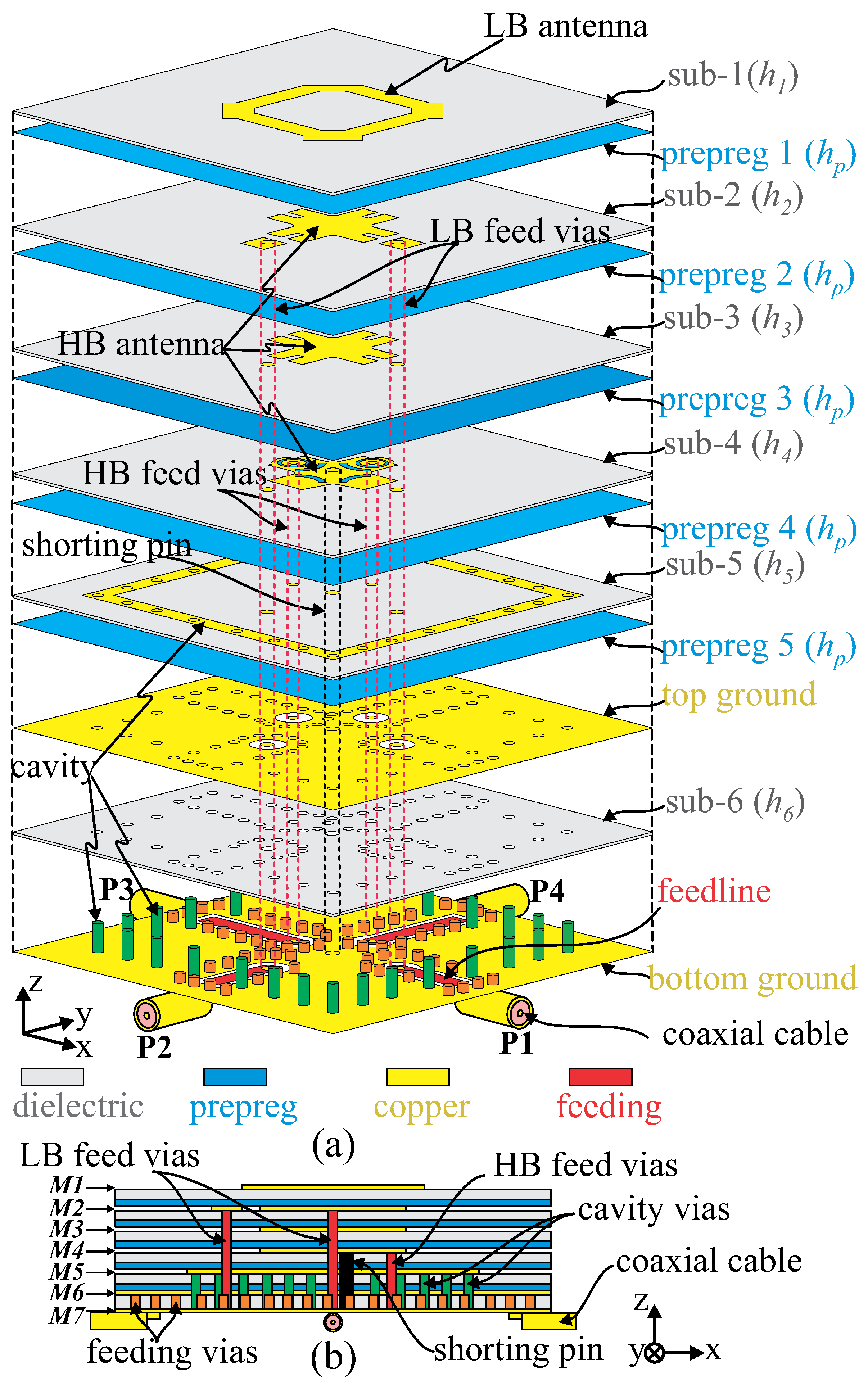
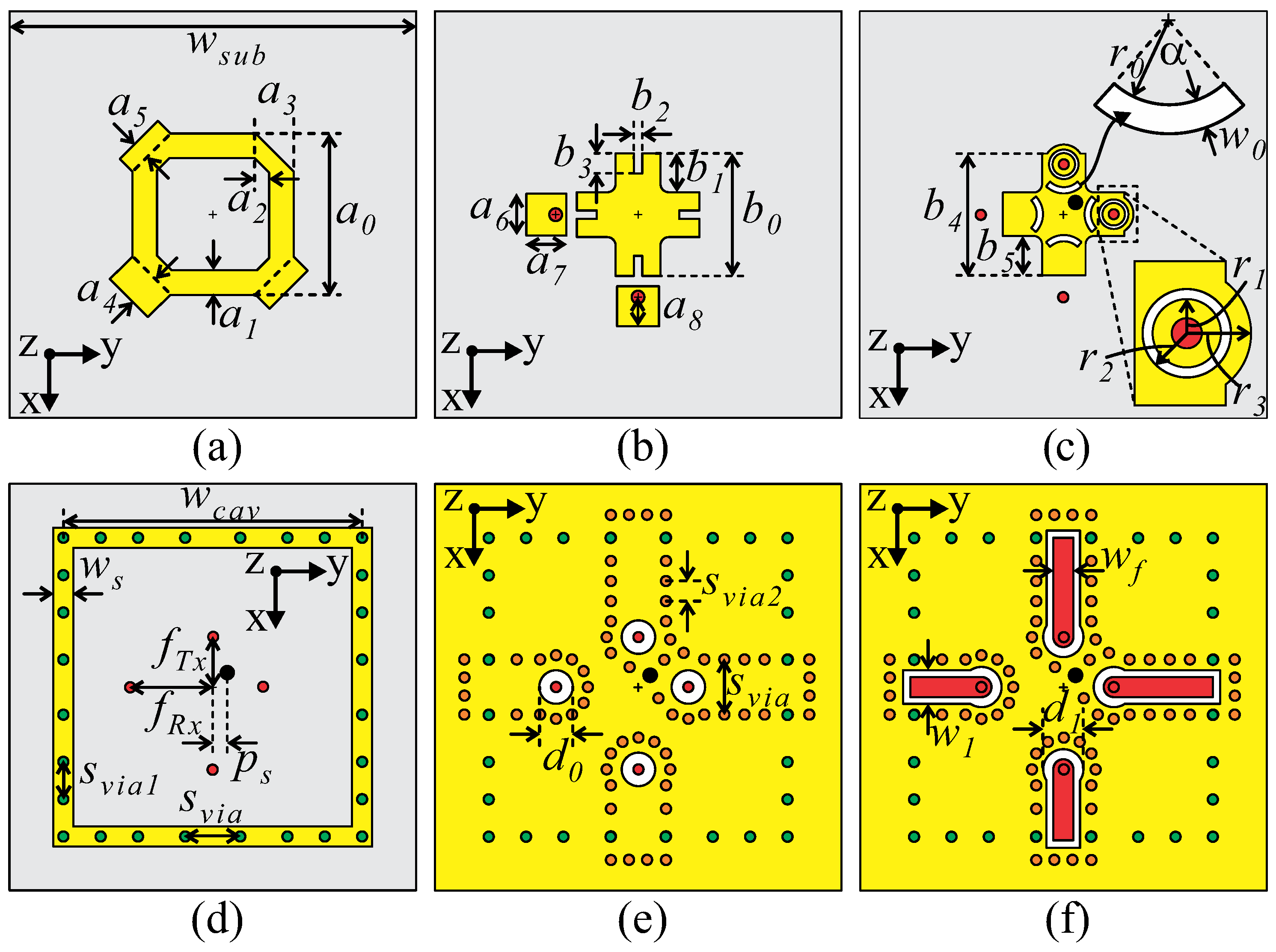
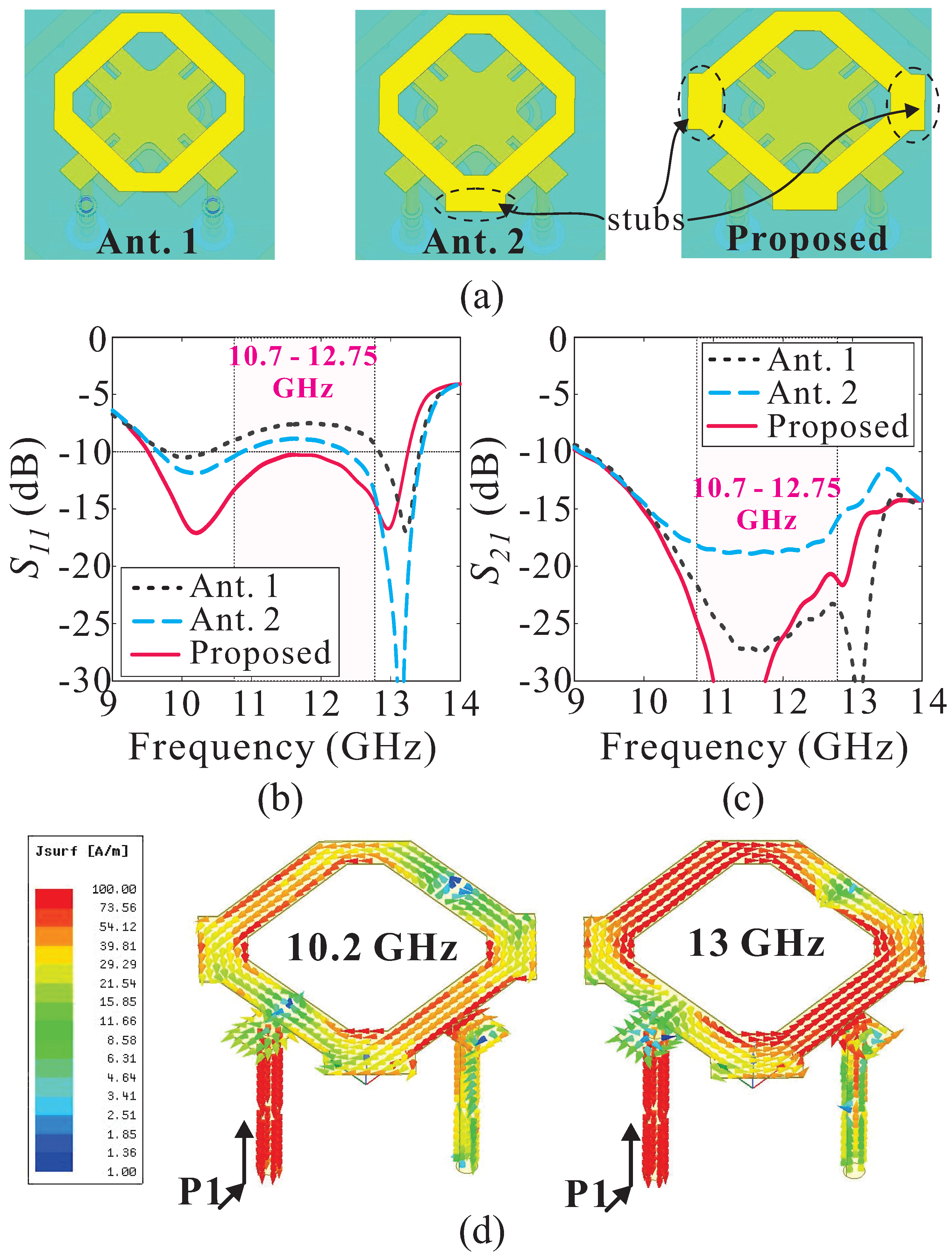
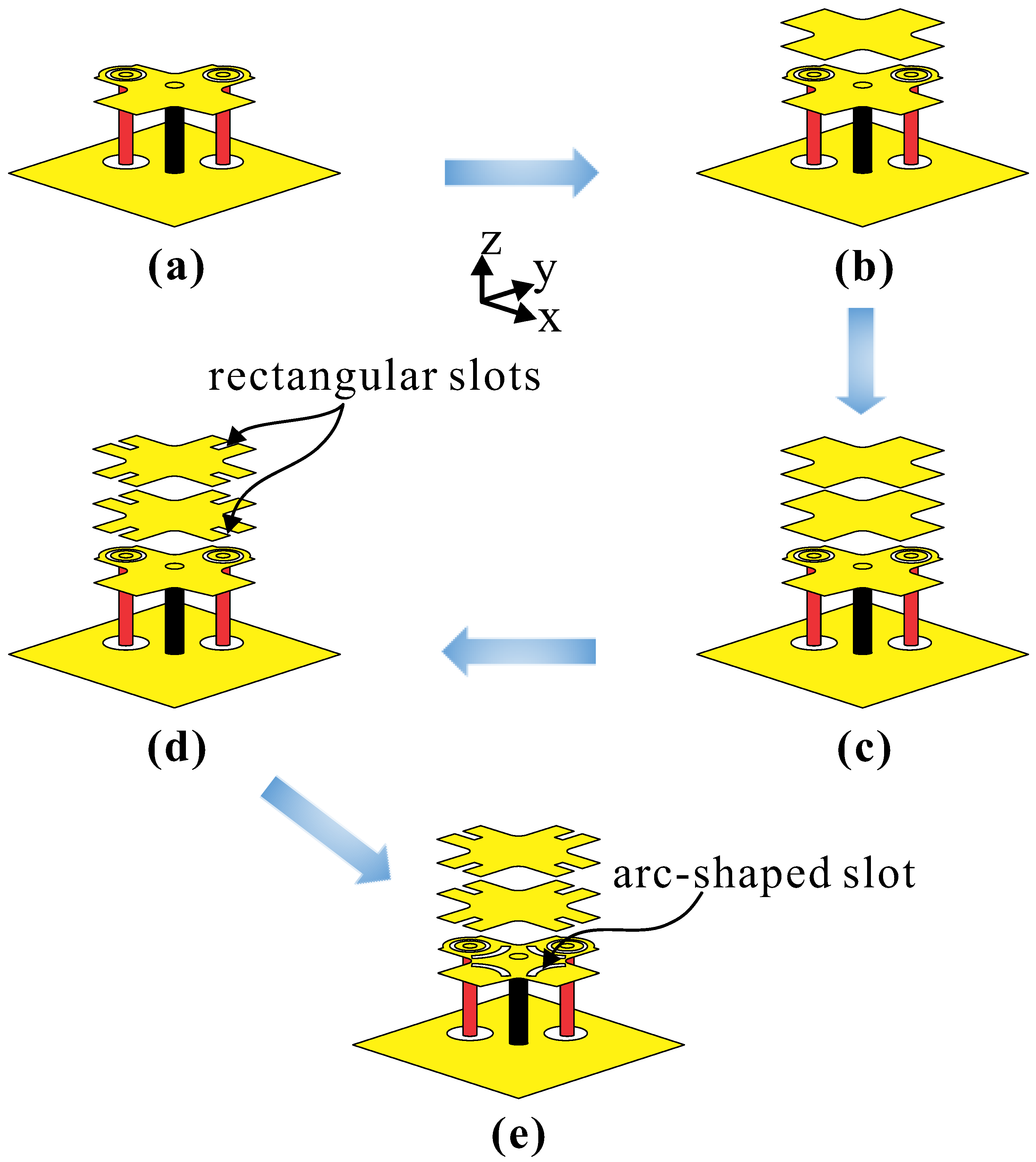

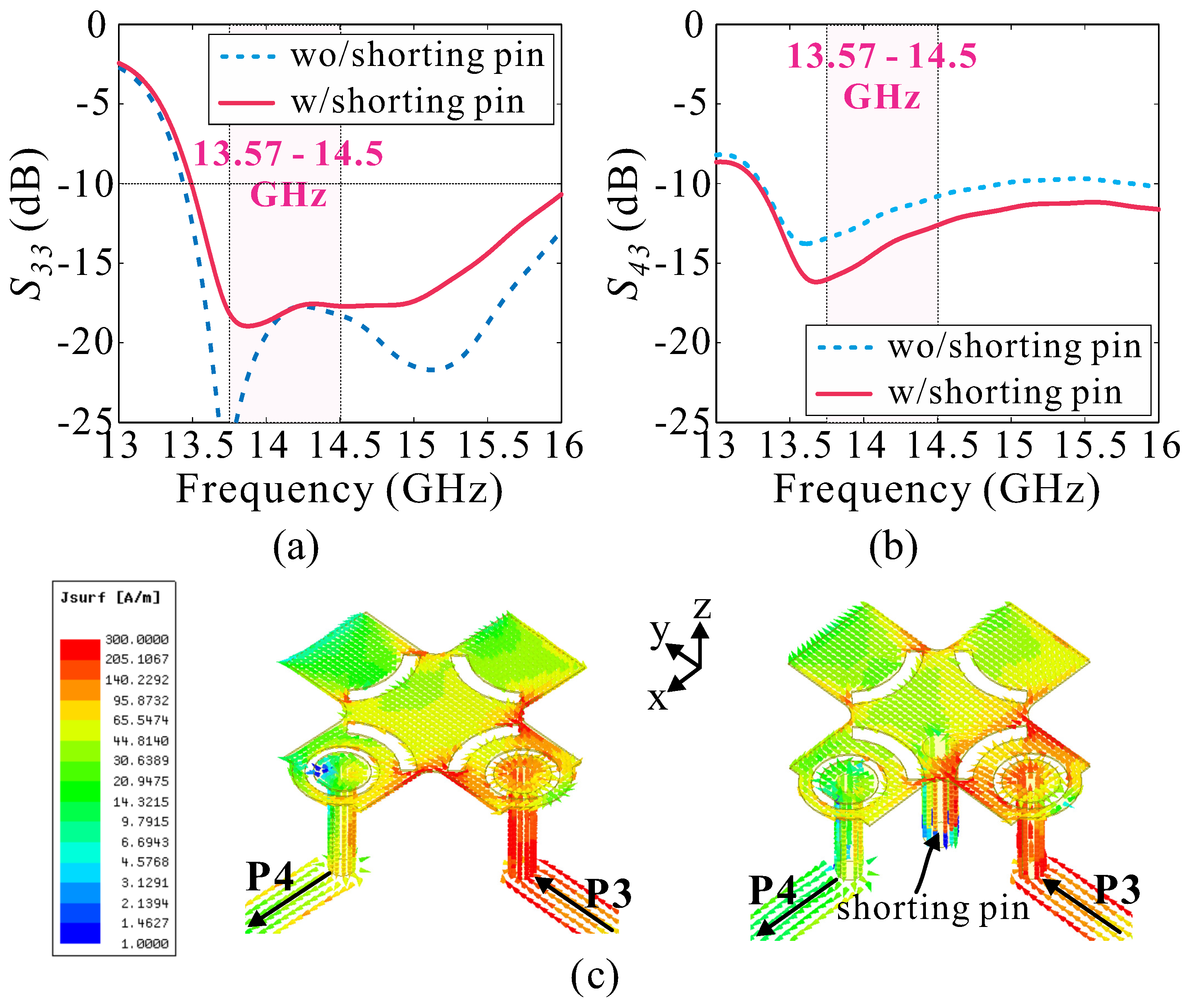
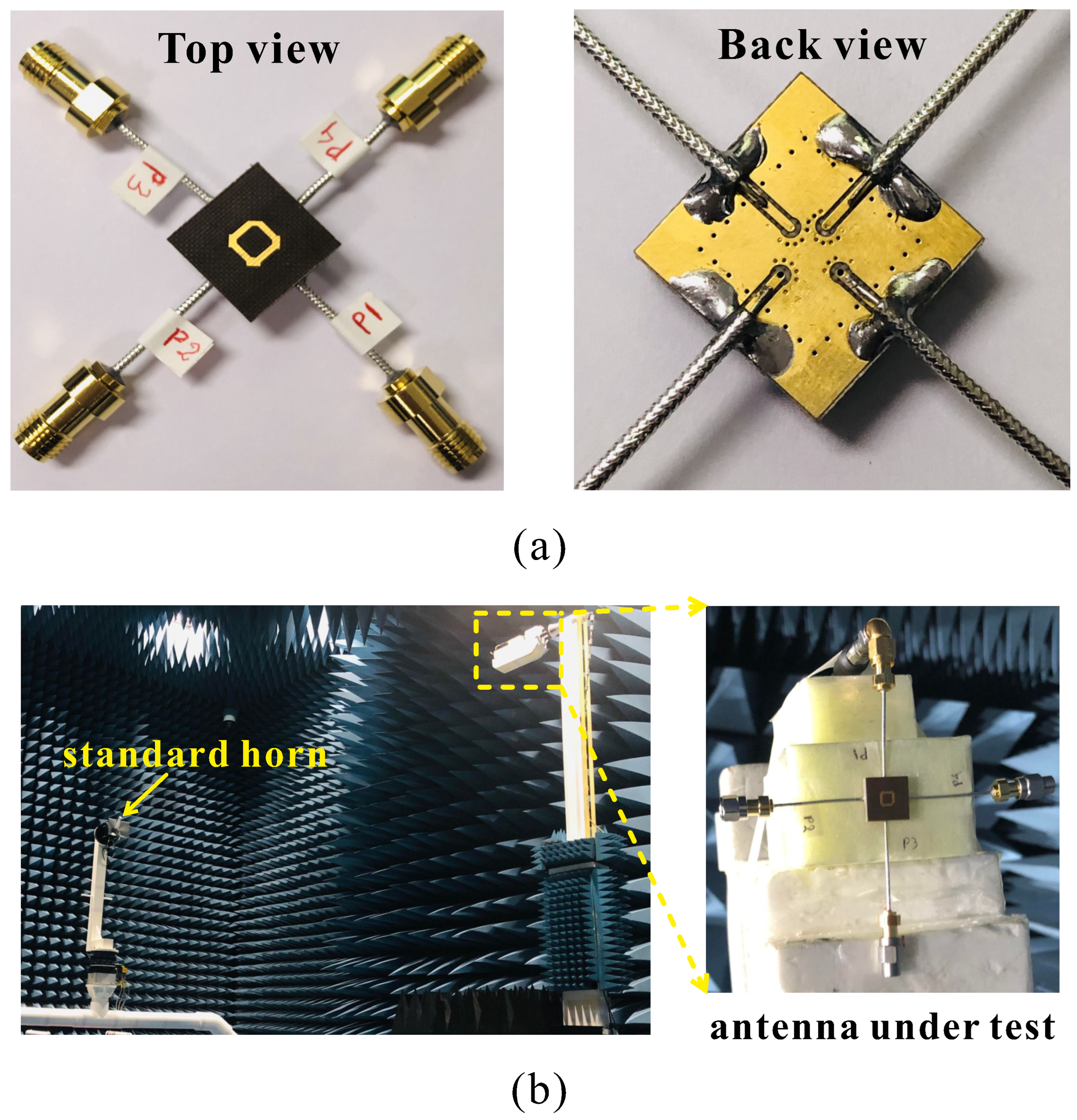
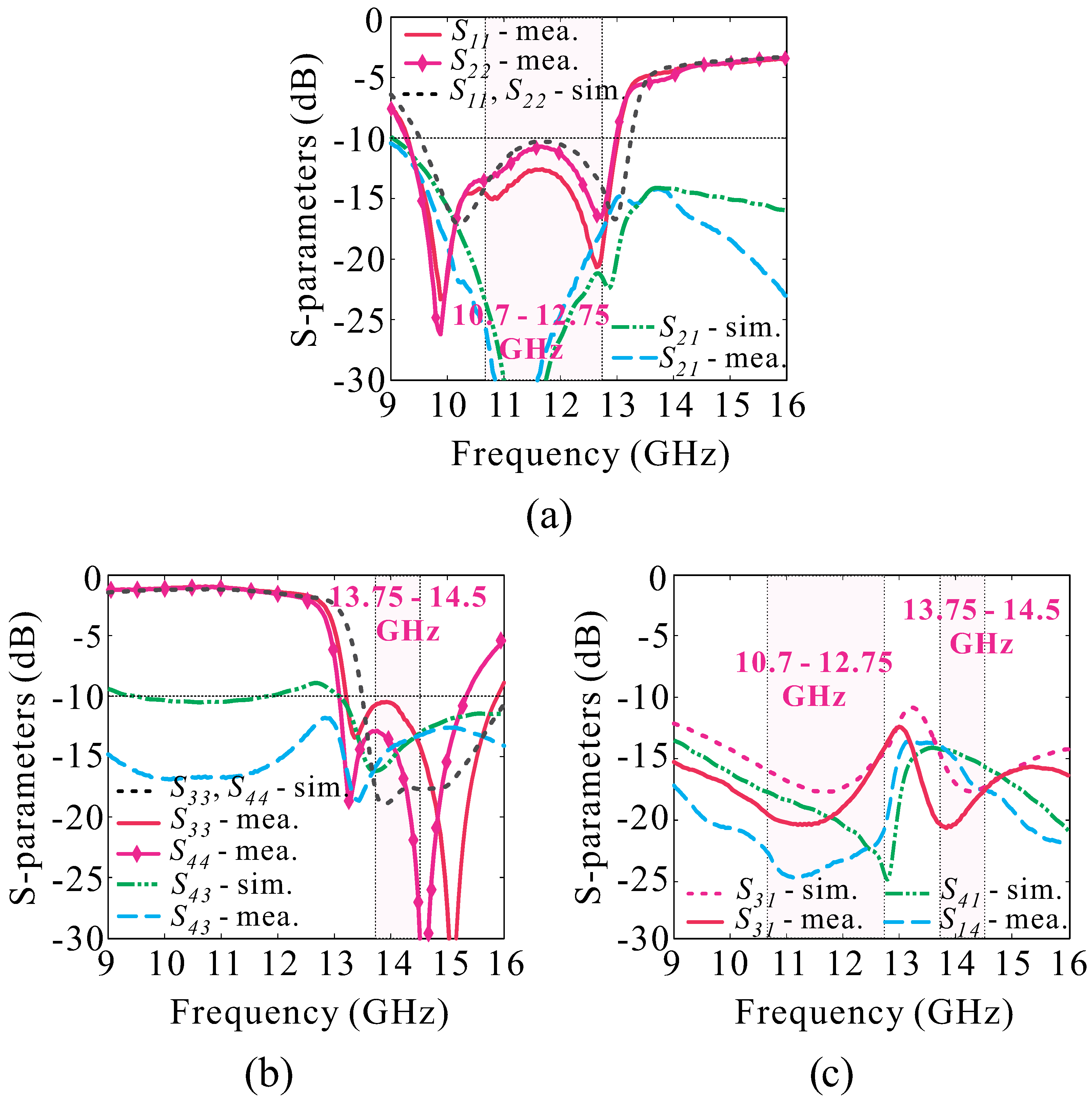
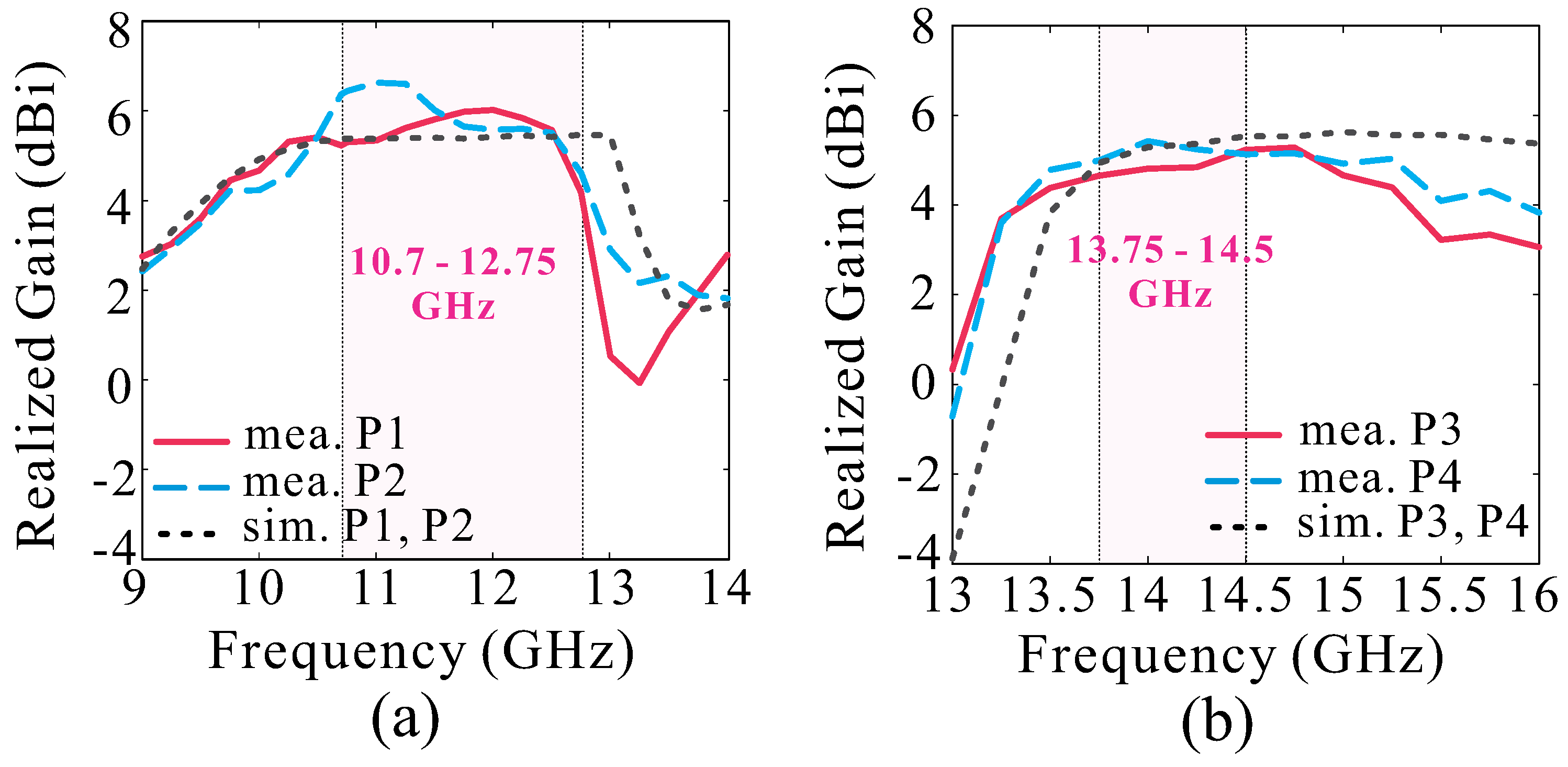
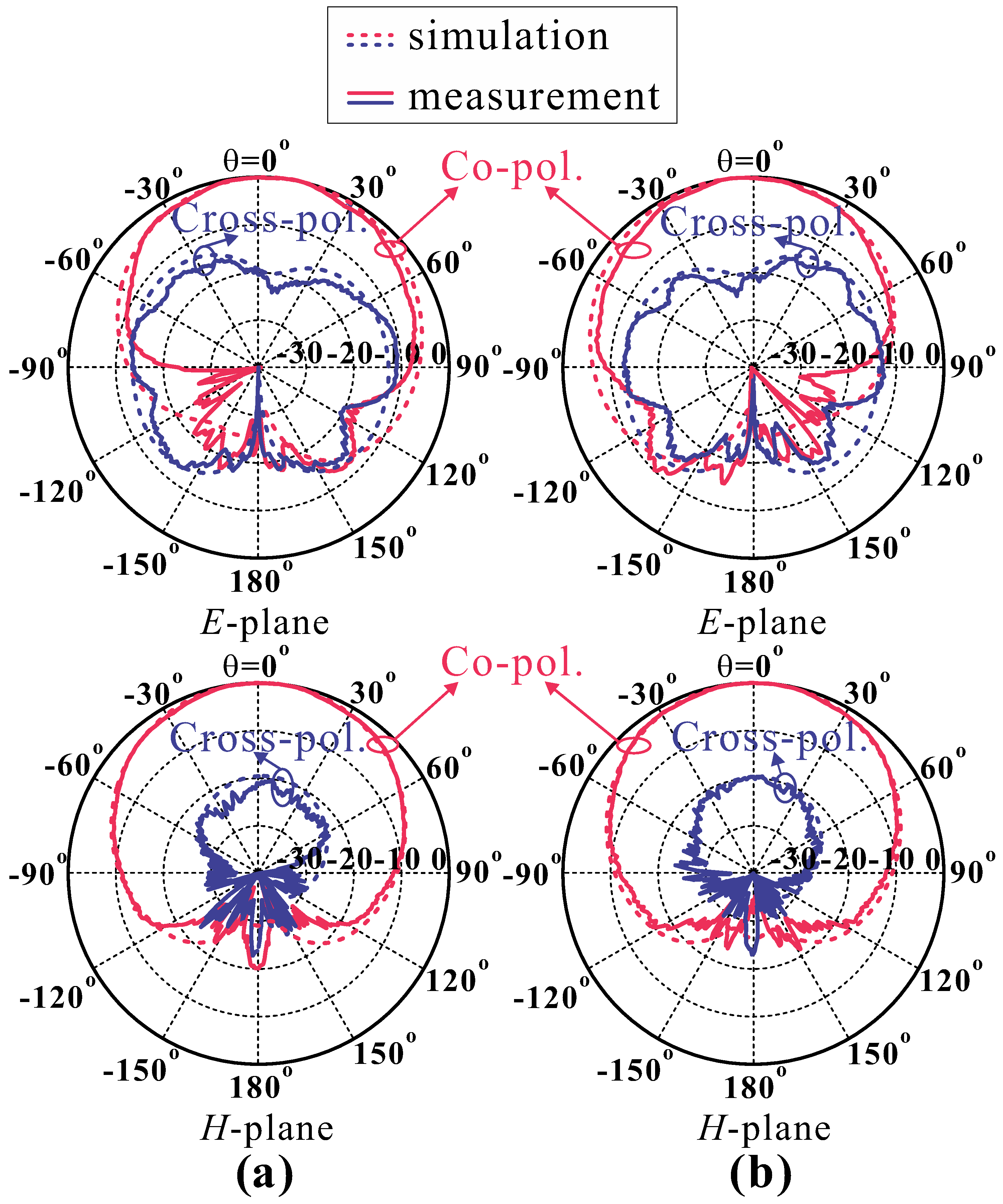
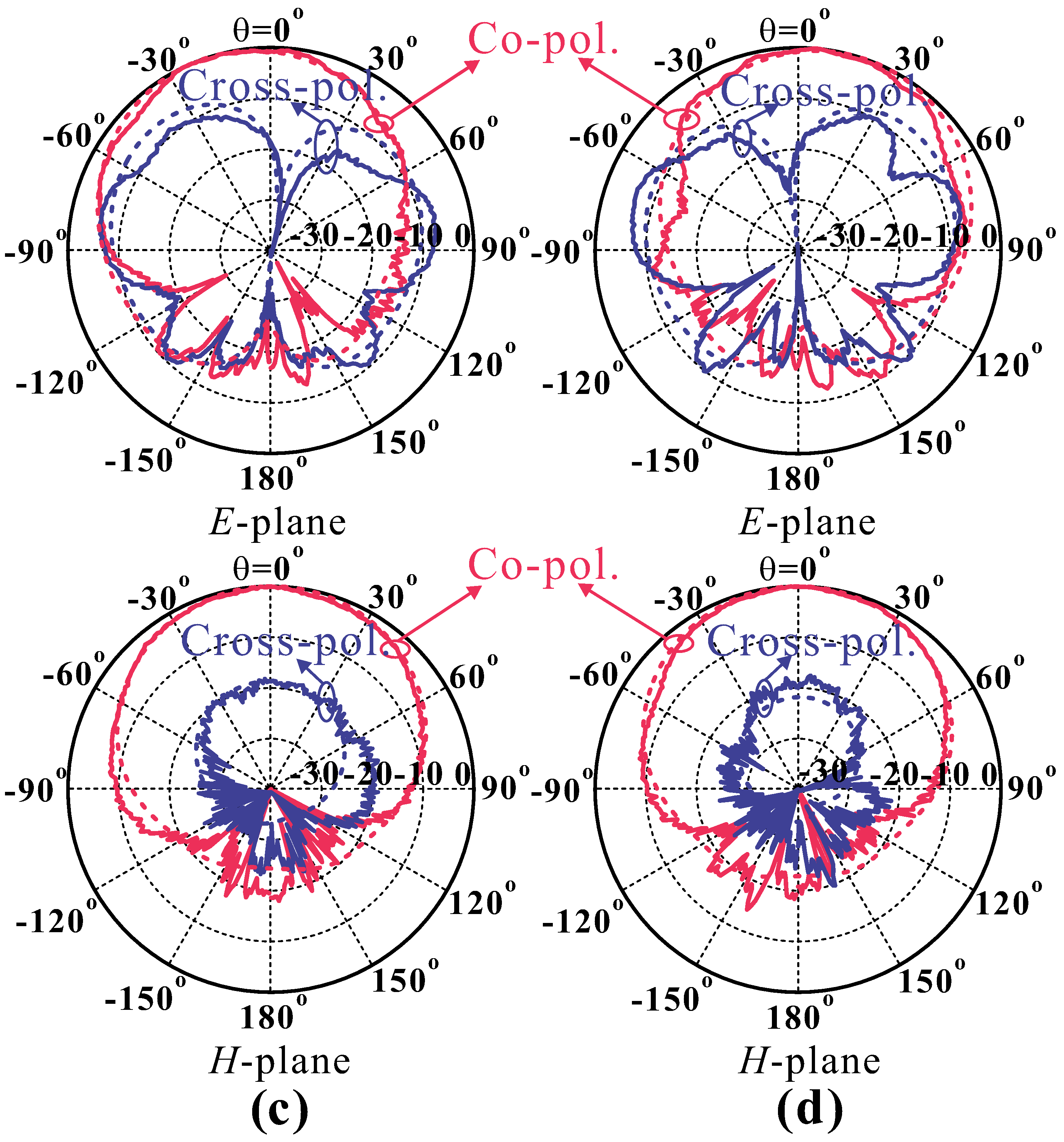
| Ref. | IBWs LB/HB [%] | Peak Gain LB/HB [dBi] | Frequency Ratio | Tx/Rx Isolation | Size [] |
|---|---|---|---|---|---|
| [13] ★ | 23.7/12.8 | N.M. | 1.7 | >17 | 0.64 × 0.64 |
| [14] ★ | 22/16 | 5.0/5.0 | 1.5 | N.M. | 50 × 0.50 |
| [15] | 28.3/29.4 | 7.04/6.94 | 2.0 | N.M. | 0.83 × 0.83 ★★ |
| [16] ★ | 8.0/10.0 | 8.7/8.3 | 2.0 | N.M. | 0.75 × 0.75 |
| [17] | 13.7/5.3 ★★ | 8.0/7.0 | 1.2 | >17 | 0.86 × 0.86 |
| Proposed | 33.10/14.79 | 6.63/5.42 | 1.2 | >14 | 0.56 × 0.56 |
Disclaimer/Publisher’s Note: The statements, opinions and data contained in all publications are solely those of the individual author(s) and contributor(s) and not of MDPI and/or the editor(s). MDPI and/or the editor(s) disclaim responsibility for any injury to people or property resulting from any ideas, methods, instructions or products referred to in the content. |
© 2024 by the authors. Licensee MDPI, Basel, Switzerland. This article is an open access article distributed under the terms and conditions of the Creative Commons Attribution (CC BY) license (https://creativecommons.org/licenses/by/4.0/).
Share and Cite
Trinh-Van, S.; Yang, W.Y.; Cho, H.W.; Hwang, K.C. A Four-Port Dual-Band Dual-Polarized Antenna for Ku-Band Satellite Communications. Appl. Sci. 2024, 14, 2730. https://doi.org/10.3390/app14072730
Trinh-Van S, Yang WY, Cho HW, Hwang KC. A Four-Port Dual-Band Dual-Polarized Antenna for Ku-Band Satellite Communications. Applied Sciences. 2024; 14(7):2730. https://doi.org/10.3390/app14072730
Chicago/Turabian StyleTrinh-Van, Son, Woo Yong Yang, Hyung Won Cho, and Keum Cheol Hwang. 2024. "A Four-Port Dual-Band Dual-Polarized Antenna for Ku-Band Satellite Communications" Applied Sciences 14, no. 7: 2730. https://doi.org/10.3390/app14072730
APA StyleTrinh-Van, S., Yang, W. Y., Cho, H. W., & Hwang, K. C. (2024). A Four-Port Dual-Band Dual-Polarized Antenna for Ku-Band Satellite Communications. Applied Sciences, 14(7), 2730. https://doi.org/10.3390/app14072730






